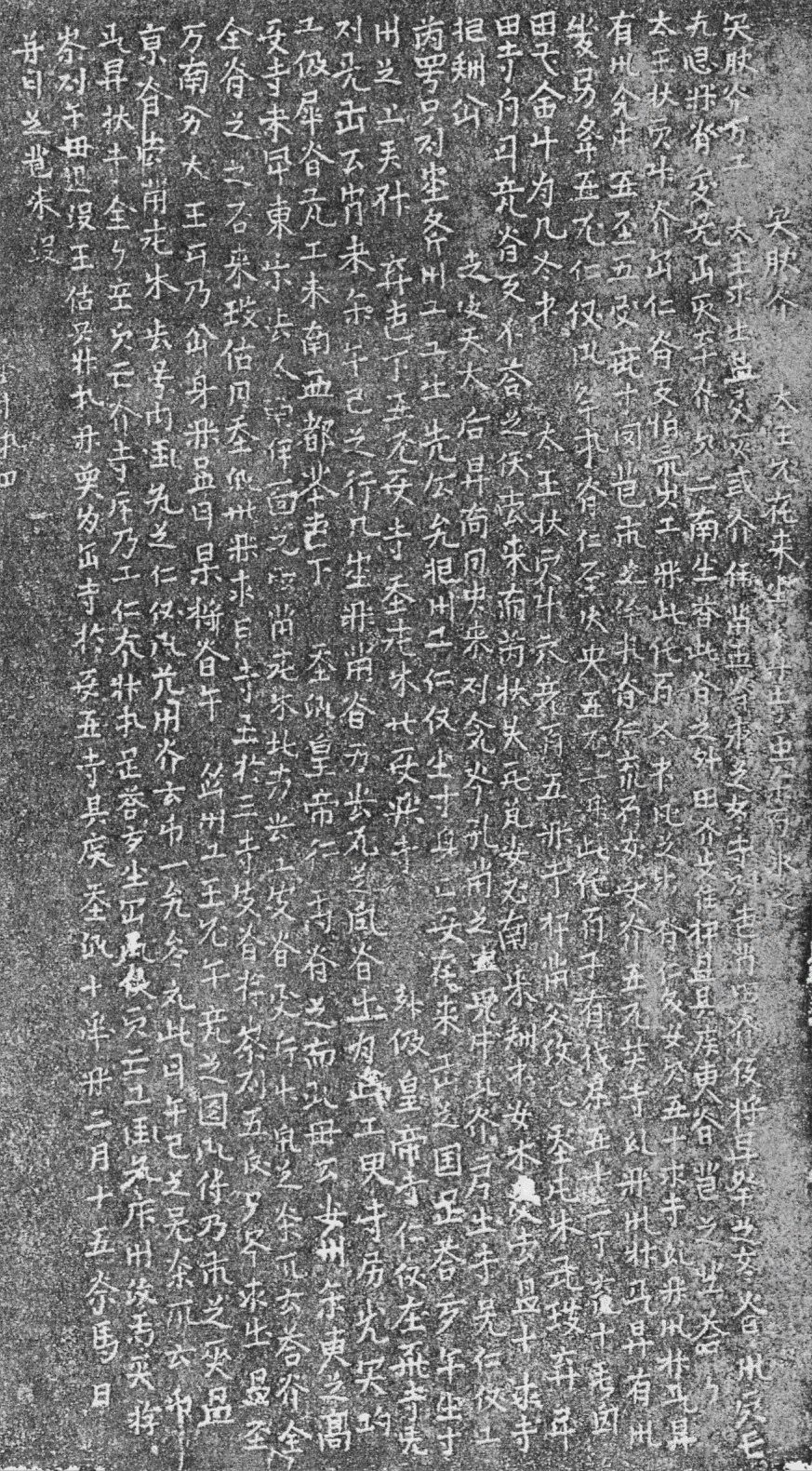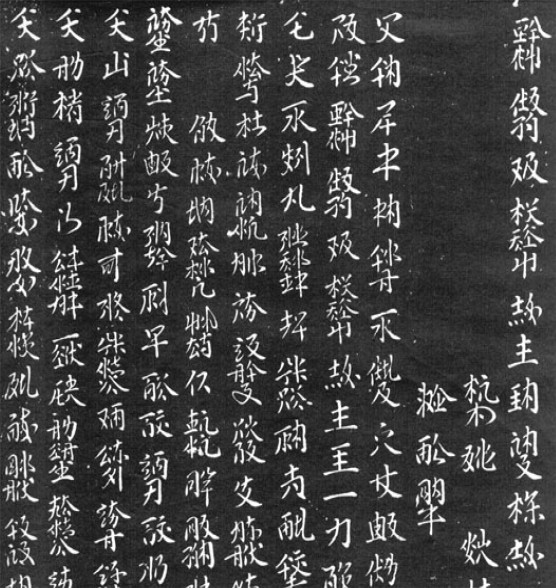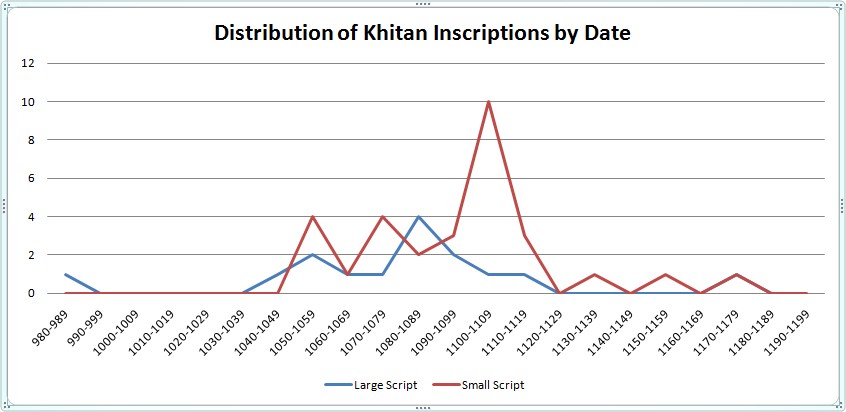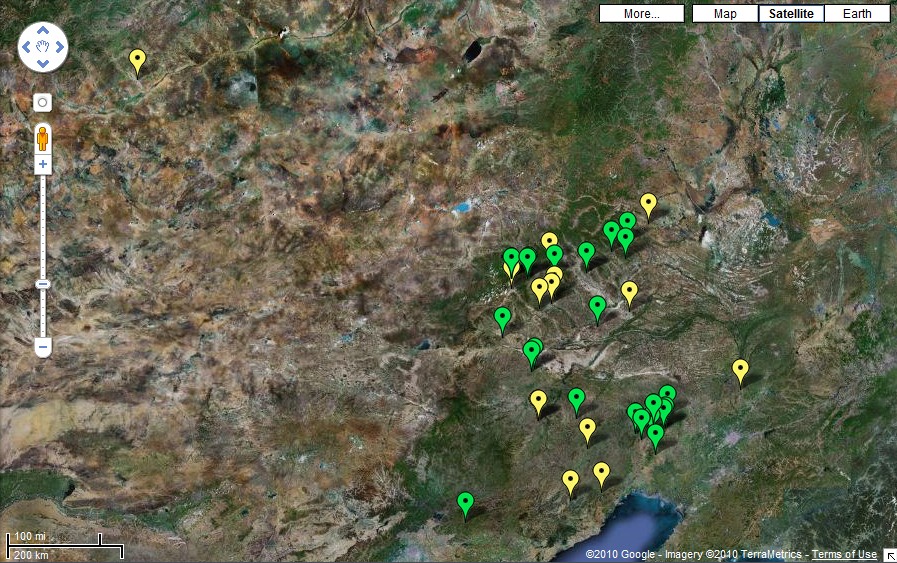BabelStone Blog
Sunday, 26 December 2010
The Mystery of Two Khitan Scripts
The Khitan people who lived in northern China during the 10th through 13th centuries spoke the now extinct, and poorly understood, Khitan language. For me, the most intriguing thing about the Khitan language is that it was written using two different writing systems.
Khitan Large Script (契丹大字)
The "Khitan large script" is a logographic/syllabic script derived from and imitating Chinese characters (see How Complex is Tangut ? for a discussion of the relative complexities of the Tangut, Jurchen and Khitan large scripts). It comprises several hundred characters that each have a distinct logographic meaning or syllabic pronunciation. These characters are not only similar in form and construction to Chinese characters, but up to 30% of the known Khitan large characters are borrowed directly from Chinese for use as phonetic borrowings or to represent borrowed words from Chinese (see for example the borrowed characters 皇帝 "emperor" and 囯 "country" in the Memorial of the Prince of the North shown below). Some of the characters in the later Jurchen script appear to be derived from Khitan large characters, and have a common pronunciation or meaning.

Part of a rubbing of the memorial stone of the Prince of the North (Khitan large script)
Khitan Small Script (契丹小字)
The "Khitan small script" is a mixed writing system that mostly comprises phonetic elements that are joined together in a rectangular phonographic block that represents the pronunciation of a word, together with a relatively small number of logographic characters that are used to represent frequently used vocabulary such as numbers and the cardinal directions. The phonetic elements that make up phonograms appear to be derived from Chinese characters, and some of them are the same as Khitan large characters, although none of the Khitan small script logographic characters are the same as the corresponding Khitan large script logographic characters.

Part of a rubbing of the memorial tablet of Emperor Daozong (Khitan small script)
The phonetic elements are arranged in groups of one through seven characters as shown below.

Arrangement of phonetic elements making up phonograms in the Khitan small script
What's the Difference ?
Our understanding of the two Khitan scripts, and the language they were used to write, is severely limited by the lack of any contemporary dictionaries or glossaries of the Khitan language. The Tangut people were contemporaneous with the Khitan, but they lived in the more arid region to the west of the Khitan territory, and large numbers of manuscripts and printed texts in the Tangut script have been found, buried in the sands of the ruins of the Tangut fortress city of Khara-Khoto and elsewhere, including several dictionaries and glossaries that have enabled the Tangut language to be largely deciphered. It is almost certain that the Khitans would also have produced dictionaries and phonological texts, but due to the accidents of geography not a single manuscript or printed text in either Khitan script has survived [not correct — see Addendum A at the end of this post]. What have survived, however, are a fairly large number of stone memorial tablets for members of the Khitan nobility, as well as a number of short inscriptions on various portable artefacts.
There are about fifty known monumental inscriptions in the two Khitan scripts, of which about 17 are in the Khitan large script and about 33 are in the Khitan small script, which suggests that the small script was more widely used than the large script, but it is not known why the Khitan people used these two different scripts, or what determined the choice of which script to use. Japanese uses multiple different scripts (kanji, hiragana and katakana), but these are differentiated functionally, and are normally used in conjunction within the same text; whereas the two Khitan scripts appear to be mutually exclusive as they never occur together on the same monument or artefact. Why then are there two Khitan scripts ?
Hypothesis A : Chronological Variation
The first idea that springs to mind is the possibility that the two scripts were not used at the same time. Perhaps one script was used first, but was later displaced by the other script. According to the History of the Liao (see juan 2, 75 and 89), the Khitan large script was created by order of Emperor Taizu of Liao with the assistance of Yelü Tulübu 耶律突呂不 and Yelü Lubugu 耶律魯不古, and was introduced at the start of the year 920. The small script was reputedly devised four or five years later, influenced by the Uyghur script, by Yelü Diela 耶律迭剌, the younger son of Emperor Taizu. We might therefore expect that the large script was used during the reign of Emperor Taizu, and the phonetic small script gradually become more widely used after the death of the emperor in 926, eventually displacing the more cumbersome large script. However, this is not borne out by the extant corpus of inscriptions.
| Year | Inscription |
|---|---|
| 986 | Memorial for Yelü Yanning 耶律延寧 (946–985) |
| 1041 | Memorial for the Prince of the North 北大王 (Yelü Wanxin 耶律萬辛, 972–1041) |
| 1056 | Memorial for an unknown person |
| 1056 | Memorial for the Grand Preceptor (太師) |
| 1058 | Stone inscription from Dornogovi Province, Mongolia |
| 1062 | Memorial for Yelü Changyun 耶律昌允 (1000–1061) |
| 1072 | Memorial at Jing'an Temple (靜安寺) errected by the Lady of Lanling Commandery (蘭陵郡夫人) |
| 1081 | Memorial for Lord Dorlipun 多羅里本郎君 (1037–1080) |
| 1084 | Stone inscription from Khentii Province, Mongolia, commemorating a battle victory by Hutenu (Yelü Zhaosan 耶律趙三) |
| 1087 | Memorial for the Princess of Yongning Commandery 永寧郡公主 |
| 1089 | Memorial for Xiao Xiaozhong 蕭孝忠 (d.1089) |
| 1090 | Memorial for Xiao Paolu 蕭袍魯 (1018–1089) |
| 1094 | Bronze seal from Panshan |
| 1108 | Memorial for Yelü Ji 耶律褀 (1033–1108) |
| 1114 | Memorial for Yelü Xinie 耶律習涅 (1063–1114) |
| 1176 | Memorial for Lord Li Ai 李爱郎君 |
| Year | Inscription |
|---|---|
| 1053 | Memorial for Yelü Zongjiao 耶律宗教 (992–1053) |
| 1055 | Memorial for Emperor Xingzong of Liao 興宗 (1015–1054) |
| 1057 | Memorial for Xiao Linggong 蕭令公 (Xiao Fuliu 蕭富留) |
| 1058 | Memorial for an unknown person |
| 1068 | Memorial for Xiao Tuguci 蕭圖古辭 |
| 1072 | Memorial for Yelü Renxian 耶律仁先 |
| 1076 | Memorial for Empress Renyi 仁懿皇后 (?–1076) |
| 1076 | Memorial for Yelü Gaoshi 耶律高十 or Han Gaoshi 韓高十 (1015–?) |
| 1078 | Memorial for Madam Han 韓氏, second wife of the imperial son-in-law, Xiao Temei 蕭特每 |
| 1082 | Memorial for Yelü Cite 耶律慈特 (1043–1081) |
| 1085 | Memorial for Lord Yelü Yongning 耶律永寧郎君 (1059–1085) |
| 1092 | Memorial for Yelü Dilie 耶律迪烈 or Han Dilie 韓迪烈 (1026–1092) |
| 1094 | Memorial for Yelü Zhixian 耶律智先 |
| 1099 | Memorial for Yelü Nu 耶律奴 (1041–1098) |
| 1100 | Memorial for the Grand Preceptor Shilu 室魯太師 |
| 1100 | Memorial for Yelü Hongbian 耶律弘辨 or Yelü Hongyong 耶律弘用 |
| 1101 | Memorial for Emperor Daozong of Liao 道宗 (1032–1101) |
| 1101 | Memorial for Empress Xuanyi 宣懿皇后 (1040–1075) |
| 1101 | Memorial for Yelü Dilie 耶律敵烈 or Han Dilie 韓敵烈 (1034–1100) |
| 1102 | Memorial for Yelü Jiuli 耶律糺里 or Yelü Gui 耶律貴 (1061–1102) |
| 1102 | Memorial for Yelü Fubushu 耶律副部署 or Yelü Fushu 耶律副署 (1031–1077) |
| 1105 | Memorial for the Prince of Xu 許王 |
| 1107 | Memorial for the Prince of Liang 梁國王 |
| 1108 | Memorial for the Inspector of Zezhou 澤州刺史 |
| 1110 | Memorial for the Imperial Consort of Song and Wei 宋魏國妃 (?–1090) |
| 1110 | Memorial for Yelü Hongben 耶律弘本 (1041–1110), the Imperial Grand Uncle 皇太叔祖 |
| 1115 | Memorial for Madam Yelü 耶律氏 (Yelü Tabuye 耶律挞不也) |
| 1134 | Record of the Younger Brother of the Emperor of the Great Jin Dynasty (Da Jin huangdi dutong jinglüe Langjun xingji 大金皇弟都統經略郎君行記) |
| 1150 | Memorial for Xiao Zhonggong 蕭仲恭 |
| 1171 | Memorial for the Jin Dynasty Defense Commissioner of Bozhou 金代博州防禦使 |
The first noticable feature of the above tables is that there are no dated Khitan inscriptions dating to the time of Emperor Taizu or any time soon after. Except for a single large Khitan inscription dating to 986, the earliest dated inscriptions only date back to the mid 11th century, over a hundred years after the recorded creation of both scripts. Clearly the large script was not displaced soon after the death of Emperor Taizu. On the contrary, the two scripts seem to have coexisted happily for at least two hundred years, from the mid 11th century, through the fall of the Liao dynasty (907–1125), and into the first half of the Jin dynasty (1115–1234). Both scripts seem to have continued in use up to at least the 1170s, with neither displacing the other, and it was only with the proscription of Khitan by the Jurchen court in 1191–1192 that both scripts finally fell out of use.

Distribution of Khitan Inscriptions by Date
Hypothesis B : Geographic Variation
If the Khitan scripts do not show any significant chronological variation, then perhaps they show a different geographical distribution, with the Khitan small script used in one part of the Khitan territory, and the large script in another part of the Khitan territory. But this does not appear to be supported by the distribution map shown below (click on the map to explore it in greater detail). Although there does seem to be some clustering of small script inscriptions, there is no obvious geographical distinction between the two scripts.
Location of Khitan Inscriptions (yellow = large script, green = small script)
Hypothesis C : Different Functional Usage
Perhaps the two scripts had different functions, for example one for writing religious texts and one for writing secular texts, or one for writing official and court documents and one for writing private and personal documents ? But as both scripts were commonly used for exactly the same function (writing memorials for the dead) this theory seems to be a non-starter.
Hypothesis D : Different Social Usage
Maybe the two different scripts were used by two different sections of the Khitan population. Was one script used by men and the other script used by women ? This seems not to be the case, as both scripts are used to write memorials for both men and women. Was one script used by royalty and nobility, and the other script used by commoners ? Probably not, as there are memorials to princes and princesses in both scripts, although the only memorials to emperors and empresses found so far are in the small script. Were the scripts used by different clans ? Again, there is no evidence for this, as both scripts were used to write memorials for members of the Yelü 耶律 clan.
Hypothesis E : Different Linguistic Usage
A final possibility is that the two scripts were used to write two different languages or dialects. Although there is no evidence that the Khitans spoke more than a single language, it is a possibility that cannot be discounted. But it is a theory that is difficult to prove or disprove as most of the Khitan words that have been identified in the small script are borrowings from Chinese, and almost all the large Khitan script words for which a reading has been proposed are also borrowings from Chinese.
Having looked at and discounted the various possibilities outlined above, we seem to be none the wiser about why there were two completely different ways of writing the Khitan language. Both scripts are complex enough to require a considerable investment of time and effort to learn to read and write, so how is it possible that both scripts managed to coexist and flourish for so long ? Did the Khitan education system require students to learn both scripts, or were Khitan scholars only able to read and write one or other of the two scripts ? It makes no sense to me ...
Addendum A [2011-10-15]
Unbeknownst to me at the time I wrote this post, less than a month earlier, on the 29 November 2010, Viacheslav Zaytsev of the Institute of Oriental Manuscripts [IOM] in Saint Petersburg had announced his identification of a 100+ page manuscript codex as being written in the Large Khitan script. This manuscript had been held at the IOM for many years, but as it was written in a cursive hand no-one had been able to identify the script with certainty. Most experts who had seen the manuscript had thought it was probably written in the Jurchen script, but by carefully comparing the text of the manuscript with memorial inscriptions written in Large Khitan, Zaytsev had been able to identify stretches of text that occured in both, and he was thereby able to prove for the first time that the manuscript was written in the Large Khitan script. This is the first and only manuscript written in either Large or Small Khitan to have been identified.
Addendum B [2011-10-21]
Viacheslav Zaytsev has drawn my attention to the fact that a fragment of a Khitan large script inscription was identified by Wang Ding in 2002. I discuss this fragment in Khitan Miscellanea 1.
Index of BabelStone Blog Posts
